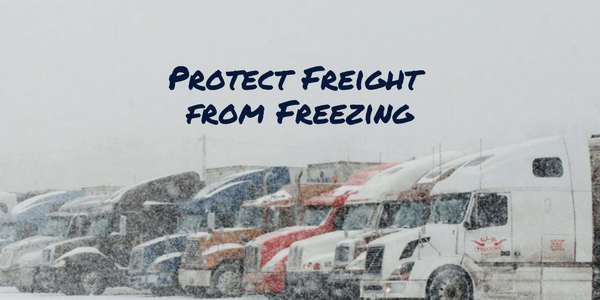Does your merchandise have the potential to freeze during transit? Food and beverage products, cosmetics, and many other goods can be irrevocably damaged if exposed to subzero temps.
The issue is most easily illustrated with beverages. Liquids expand when they freeze, creating pressure inside closed bottles. Some packaging is built to withstand small levels of expansion and retraction, but glass and aluminum containers or over-filled plastic bottles are notorious for bursting.
Broken bottles and busted cans leave behind a mountain of mess for carriers. Not to mention, a completely ruined shipment and added cost for cleanup.
Understandably, many carriers are unwilling to take on the liability of product that may freeze and explode in transit. Some will issue an embargo (an official ban) on freight that can be damaged by low temperatures, not lifting until temperatures rise.
Luckily, other carriers offer Freeze Protection services and there are a plethora of available solutions and prevention protocols. These services are typically marked up as accessorial charges.
You, or your 3PL, should be asking carriers what their policies are for freezable products and low-temp conditions. Those who do not have Freeze Protection programs are unlikely to take on your cargo. Communicating up front will help ensure no products are damaged, no shipments are canceled, and everything stays on target.
General reminders:
- Be cognizant of products being shipped in the Midwest and Northeast where temperatures are lowest – pay attention to weather forecasts and plan ahead
- Communicate upfront with service providers to learn about Freeze Protection options and costs
- Include freeze protection directions on your Bill of Lading (BOL)
Ways to Protect Shipments in Freezing Temperatures
Temperature controlled vehicles
Against conventional thinking, refrigerated trucks can be used to keep products above freezing. They are equipped to help maintain specific temperatures throughout transit and can safeguard against outside conditions.
Use technology to monitor product temperature during transit
While these technologies won’t directly prevent against freezing, they can alert you when a product is reaching potentially dangerous temperatures, forcing action. We recommend LocusTraxx. It goes directly on the pallet and enables real-time temperature tracking as well as the real-time location tracking throughout transit.
Use pallet covers or insulating cargo blankets
Pallet covers and blankets are available through most service providers and can help protect your product against freezing temperatures. Like using Styrofoam coolers for frozen parcel shipping, the insulating pallet covers and blankets lock the exterior conditions out and keep the shipment temperature constant.

Ask about heating solutions
Less-than Truckload (LTL) carriers often have solutions for isolated heating. They may have portable heaters that can go under or near blankets, or might even have built-in trailer compartments that facilitate targeted heating.
If shipping over the weekend, ensure there is protection for idle days
Warehousing of product over the weekend is not standard practice for LTL providers. Instead, pallets are cross-docked and moved back onto a trailer that sits outside. So, if you have glass bottles, liquids, or any products that could potentially be damaged, this could pose a big problem. Ask your service providers what their policies are and take any corrective steps that are necessary, including the rearrangement of schedules and pickup days.
Leverage expedited services
Prevent against possible idle time in cold temps by paying for nonstop delivery. Accelerated services will help keep freight in motion.
Wait for slightly warmer temperatures
At the other end of the spectrum, if you have extra time and don’t want to pay for freeze protect services, you can push orders out to later dates. This level of flexibility isn’t available to everyone. But if you can afford the extra time, go ahead and wait.
—
Do you have liquid or temperature-sensitive shipments that need special handling during winter months?

